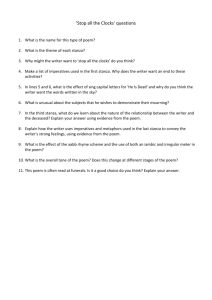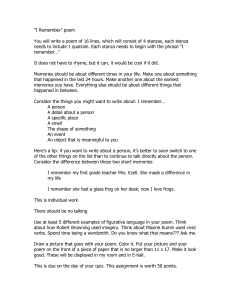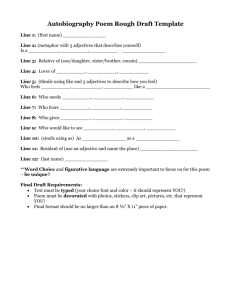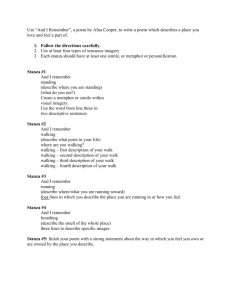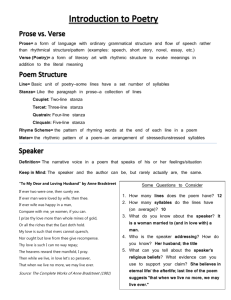CHAPTER III ANALYSIS 3.1. Maya Angelou's Life Maya Angelou
advertisement
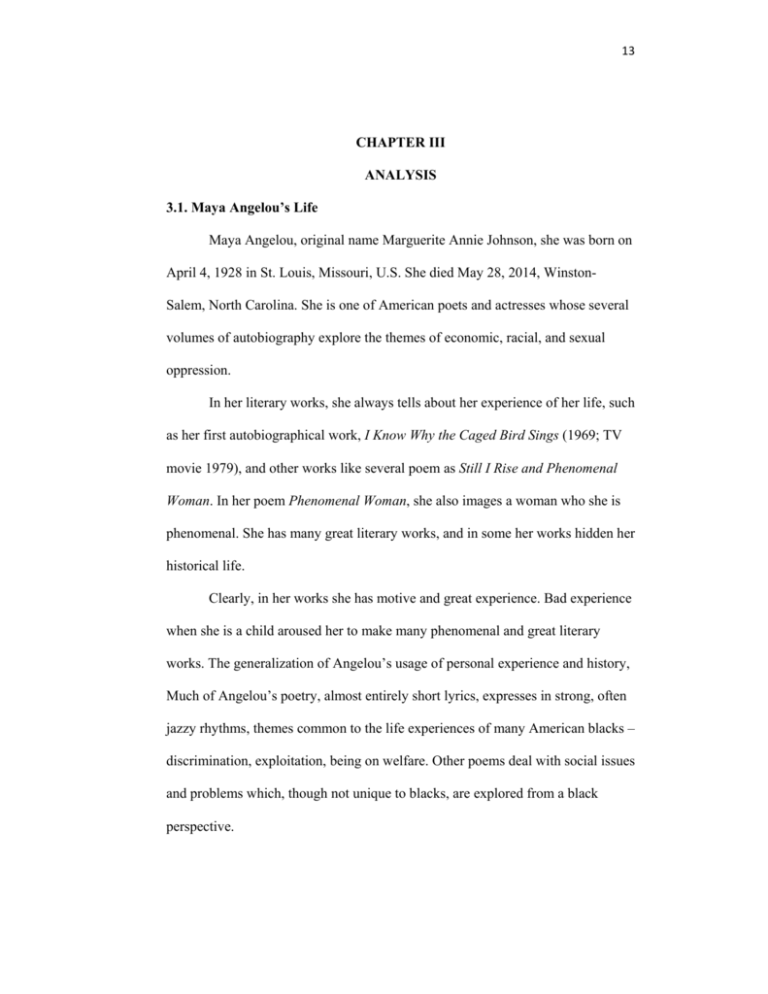
13 CHAPTER III ANALYSIS 3.1. Maya Angelou’s Life Maya Angelou, original name Marguerite Annie Johnson, she was born on April 4, 1928 in St. Louis, Missouri, U.S. She died May 28, 2014, WinstonSalem, North Carolina. She is one of American poets and actresses whose several volumes of autobiography explore the themes of economic, racial, and sexual oppression. In her literary works, she always tells about her experience of her life, such as her first autobiographical work, I Know Why the Caged Bird Sings (1969; TV movie 1979), and other works like several poem as Still I Rise and Phenomenal Woman. In her poem Phenomenal Woman, she also images a woman who she is phenomenal. She has many great literary works, and in some her works hidden her historical life. Clearly, in her works she has motive and great experience. Bad experience when she is a child aroused her to make many phenomenal and great literary works. The generalization of Angelou’s usage of personal experience and history, Much of Angelou’s poetry, almost entirely short lyrics, expresses in strong, often jazzy rhythms, themes common to the life experiences of many American blacks – discrimination, exploitation, being on welfare. Other poems deal with social issues and problems which, though not unique to blacks, are explored from a black perspective. 14 In my own analysis I discovered that Maya Angelou mostly writes from her environment and this poem falls perfectly in that category. She faced constant discrimination as a woman, particularly an African American woman. She also thought that she was never terribly pretty. She allowed this dissatisfaction to grow, but when she became older she killed it with the sense of pride she gained. As a child, Angelou was sexually abused. When she told her family about the terrible occurrence, the man was killed. She chose to remain silent for the next five years until a teacher, Mrs. Flowers, introduces the young girl to an assortment of literary classics, including the works of Charles Dickens. This educational encounter proves to be a vital turning point, reminding us of an important aspect of American slave narratives. In Caged Bird, Angelou explains the sensation of listening to Mrs. Flowers as she read from A Tale of Two Cities (1859): “I heard poetry for the first time in my life. . . . Her voice slid in and curved down through and over the words. She was nearly singing.” It is Mrs. Flowers who is finally able to get Mar-guerite to talk, having her read from works that in themselves are demanding recitation. The therapy is so effective that it must have carried over into the writer’s own poetic career, in the production of such “oral” poems as “Still I Rise” and “Phenomenal Woman.” Angelou gives the feeling of a hidden frustration and anger at the men and women who question the subject’s self-confidence. But overall Maya Angelou gives praise to the woman who loves herself. In her life, before she becomes the author, she is a dancer and a cocktail waitress. In 1940 Angelou moved with her mother to San Francisco and worked 15 intermittently as a cocktail waitress, a prostitute and madam, a cook, and a dancer. It was as a dancer that she assumed her professional name. Maya Angelou, through her powerful writings, has inspired generations of women, African Americans and all people who struggle to overcome prejudice, discrimination and abuse. Throughout her life, Angelou has defied social norms. After being raped by her mother's boyfriend, she withdrew and was mute for five years. However, encouraged by her grandmother, who introduced her to literature, she gradually emerged as a talented artist. Her diverse career includes being the first black streetcar conductor in San Francisco. 3.2. American Black Women in Angelou’s Era The nineteenth century was a time of radical transformation in the political and legal status of African Americans. Blacks were freed from slavery and began to enjoy greater rights as citizens (though full recognition of their rights remained a long way off). Despite these dramatic developments, many economic and demographic characteristics of African Americans at the end of the nineteenth century were not that different from what they had been in the mid-1800s. (http://eh.net/encyclopedia/african-americans-in-the-twentieth-century/) According to the Census, ninety percent of African Americans still lived in the Southern US in 1900 — roughly the same percentage as lived in the South in 1870. Three-quarters of black households were located in rural places. Only about one-fifth of African American household heads owned their own homes (less than half the percentage among whites). About half of black men and about thirty-five 16 percent of black women who reported an occupation to the Census said that they worked as a farmer or a farm laborer, as opposed to about one-third of white men and about eight percent of white women. Outside of farm work, African American men and women were greatly concentrated in unskilled labor and service jobs. Most black children had not attended school in the year before the Census, and white children were much more likely to have attended. So a typical African American family at the start of the twentieth century lived and worked on a farm in the South, did not own its home, and was unlikely to have its children in school. ( http://eh.net/encyclopedia/african-americans-in-the-twentieth-century/) They had become much less concentrated in the South, in rural places, and in farming jobs and had entered better blue-collar jobs and the white-collar sector. They were nearly twice as likely to own their own homes at the end of the century as in 1900, and their rates of school attendance at all ages had risen sharply. Even after this century of change, though, African Americans were still relatively disadvantaged in terms of education, labor market success, and home ownership. (http://eh.net/encyclopedia/african-americans-in-the-twentieth-century/) 3.3. Angelou’s Phenomenal Woman 3.3.1 Intrinsic Analysis of Angelou’s Phenomenal Woman The intrinsic elements are the analysis of the literature itself without looking the relation with the external aspect (Robert, 1965: 11). The intrinsic element used by the author to analyze several words in this poem. Some intrinsic elements that find in this poem are: 17 3.3.1.1. Explication of The Poem Maya Angelou published Phenomenal Woman in 1978. As we know, this poem tells about black woman who lives among whites woman. In this poem the speaker tries to send a message to the readers to appraise themselves although their physical appearance is not perfect. In this poem, Angelou uses simple words to register the implicit meaning about woman. Angelou illustrates and defines true womanhood. True womanhood is about character and sexuality. She shows the reader that the beauty of the woman is not directly related to a pretty face. It is about what a lady feels within herself. This poem has a message that every woman should be confident in who she is. The word “Phenomenal” in this poem is strength to the woman. To be a phenomenal woman, she will seen by everyone especially the men. The word “phenomenal” in this poem always repeat in every stanza, it means to explicit the struggle of woman. 3.3.1.2. Imagery In this poem, the author uses much imagery. The imagery used by the author to describe a confident and proud of herself and her physical appearance. In the first stanza: It’s in the reach of my arms, The span of my hips, The stride of my step, The curl of my lips. 18 In this stanza the author invites the reader to image the physical things of the author arms, hips, steps, and lips. She is confident and proud with her physical thing although her physicals are not whites and not sexy like a model. But the author is still confident and proud with her physical because she believes that she has something special with that. It gives the reader a knowledge that every woman must be proud with everything that they have. In the second stanza, there is imagery: I walk into a room Just as cool as you please, And to a man, The fellows stand or Fall down on their knees. Then they swarm around me, A hive of honey bees. For this stanza, the author invites the readers to imagine how the author can make a men surprise until the men stand or fall down on their knees. Whereas, in last stanza the author tells that she is not beautiful like a model or white woman. Moreover, the men swarm around her like bees swarming honey. And the reason of this stanza explained by the author in the next line. It’s the fire in my eyes, And the flash of my teeth, The swing in my waist, And the joy in my feet. In this line the author tells that she has a beautiful eyes, her eyes are shinning like fire. Besides that, her teeth are white and clean, when she 19 is smiling her teeth like flash. And her waist, when she walks her waist is swing. So in the last line, the author feels enjoy in her feet. It means that the men enjoy when she walk, every step is amazing and she can walk with the joy so every men who see her walking is amazed. 3.3.1.3. Metaphor In this poem, the writer finds the metaphor. Firstly, the writer finds metaphor in the second stanza: Then they swarm around me, A hive of honey bees. The author compared they to bees. In this poem, they means men. She means that the men who swarm around me like bees whose swarm around honey. Secondly, the writer finds metaphor in the next line: It’s the fire in my eyes, She means that her eyes flame and shine like fire, it shows strength of women. The last metaphor which the writer finds in the tenth line: The sun of my smile, The author compares the word smile to the sun. Her smile is like sun because her smile is beautiful and gives strength to the men who are seeing her. 3.3.1.4. Metonymy The writer finds the metonymy in the first stanza. 20 It's in the reach of my arms, The span of my hips, The stride of my step, The curl of my lips. The words reach, span, stride, curl signifies the less of the author’s body. But the less of her body can be her excess and make she is a phenomenal woman. 3.3.1.5. Simile The writer also finds the simile. The simile in second stanza was finding. I walk into a room Just as cool as you please, The author uses simile to compare her walk is same with the model. Her walk is beautiful. It means that the author shows her strength. If she can does the same thing like a model or the whites. Because she is a phenomenal woman. The writer tabulates the data by classifying them in one table. stanza Intrinsic analysis 1 imagery The quotation It’s in the reach of my arms, The span of my hips, The stride of my step, The curl of my lips. 21 2 imagery I walk into a room Just as cool as you please, And to a man, The fellows stand or Fall down on their knees. Then they swarm around me, A hive of honey bees. 2 metaphor Then they swarm around me, A hive of honey bees. It’s the fire in my eyes, The sun of my smile, 1 metonymy It's in the reach of my arms, The span of my hips, The stride of my step, The curl of my lips. 2 simile I walk into a room Just as cool as you please, 3.3.2. Figure Woman in Phenomenal Woman Maya Angelou describes the woman as great woman. She is always proud to herself. She has high confident. It shows in every stanza in this poem. She is so proud and confident. Because in this poem she always says: I'm a woman Phenomenally. Phenomenal woman, That's me 22 The word above repeated by the author in every stanza. It means that the author explicit the figure of the character in this poem. The repetition of the word “phenomenal woman” gives the meaning that the woman in this poem has big dreams, ambition and brave to make better life in the future. After the writer analyzes the intrinsic element of this poem, the writer finds the character woman that is created by the author. The author imagines the woman in this poem is strength, confident, and brave. Character of strength woman finds in first stanza: It's in the reach of my arms, The span of my hips, The stride of my step, The curl of my lips. The word “reach, span, stride, curl” is figure the physical thing of the woman. The writer means that word as strength because that word is not beautiful physical thing by the woman. But the woman strength to see it and she believe that it is not the less of the woman exactly. And the brave women seen by the author in the second stanza: I walk into a room Just as cool as you please, And to a man, The fellows stand or Fall down on their knees. 23 Then they swarm around me, A hive of honey bees. Statements above swarm into brave of the woman because the writer connects with the last stanza that tells about physical thing of the woman. And these stanzas explain a brave of the woman because she is brave to walk in the room. And she is brave to make different herself so everyone amazed with her. And she images she is swarmed like honey swarmed by bee. And the confident woman has seen in the next stanza: It's in the arch of my back, The sun of my smile, The ride of my breasts, The grace of my style. She is confident with compares her smile always shines every day like the sun. And then, she so confident and proud with her breasts and her style, she imagines her style grace like a model. In addition, in the last stanza the author image the result of the character woman which she is successful and make everyone proud to her. Now you understand Just why my head's not bowed. I don't shout or jump about Or have to talk real loud. 24 When you see me passing, It ought to make you proud. In this poem, the author explains that the woman in this poem is not beautiful woman, sexy or has not perfect body. But she can attract the men who see her. Her power, her confident, her brave, and her behavior became her inner mystery that make the woman is phenomenal woman. In phenomenal woman, the writer found the word “reach, span, stride, curl, fire, flash, swing, joy, arch, sun, ride, grace, click, bend, and palm”. Those words are proof the author’s confident and brave. She is proud with her body and those words as symbol to make elegant and beautiful in her body. 3.4. Intrinsic Analysis of Angelou’s Still I Rise 3.4.1. Explication of the Poem Still I Rise is the one poem of Maya Angelou. This poem published on 1978. Still I Rise is same poem with Phenomenal Woman. This poem is about the black woman who lives among whites. The whites are majority in America and they consider that the blacks are minority. In this poem, the author uses the word “you” it means that you is the whites. The whites often trifling, hurt, and treated unfairly the black woman. Still I Rise is a poem that has high motivation to black woman. The author explain her high confident, her strength to survive. She believed that with her high confident, brave, and strength she can change her life. It 25 showed by the author in the last line of her poem. Nowadays, she can make her dream true. She is not afraid of being different. 3.4.2. Imagery In this poem the writer finds some imagery that is used by the author. The imagery used to give imagination more to the reader so the reader can feel the condition that is imaged by the author. In the first stanza, the author explains about the condition and feeling of her as black woman in America. She is a minority. You may write me down in history With your bitter, twisted lies, You may trod me in the very dirt But still, like dust, I'll rise. This stanza implies the author feeling. She is sad, disappointed and unhappy. She is trod by the white. She like unkindly by the people around her. It is her bad experience and she will remember it and in the next time she will rise. However, the author is very brave and strength. She proof that she is better than the whites. In the last line the author used I'll rise. It means that she has high spirit to make a change in her life. It gives a motivation for women generally and the black women especially. Women are power. They must rise and give a change in their life. In the second stanza, the author also used imagery. It used to invite the reader to imagine the way of the author’s walk. 'Cause I walk like I've got oil wells Pumping in my living room. 26 The author says that her walk like she has got oil wells. It means that she walks with her high confident. She appoints her chin, bravely, like someone who gets oil wells. It is a visual imagery because it gives effect to the visual of the reader. Besides it, the author also used audio imagery. It gives effect for auditory of the reader. The reader can hear and imagine through author’s word. In the fifth stanza the author used the audio imagery. 'Cause I laugh like I've got gold mines Diggin' in my own backyard. From those sentences, the reader can know that the author has louder voice than the whites. When she laugh like she got gold mines. Someone feels happy if they get gold mines. It means that she feels happy if she can laugh loudly. The writer also finds other imagery in the eighth stanza. It gives image the identity of the author. I'm a black ocean, leaping and wide, Welling and swelling I bear in the tide. She shows her identity as black woman. She is never shy and afraid with her identity. She is proud with her identity. She believes that with her difference she will give a change in her life. She will become a great woman which phenomenal. 3.4.3. Symbol 27 This poem different with Phenomenal Woman poem, Phenomenal Woman is not using a symbol. And in this poem the writer used a symbol to invite the reader image deeply. The words “sassiness, haughtiness, sexiness” used as symbol to show the author’s identity. The meaning of sassiness is fashionable, interesting and confident. The meaning of sexiness is interesting and attractive. The meaning of haughtiness is she is same the whiter, moreover she is better than the whites. “Sassiness, haughtiness, sexiness” are a symbol of the power of woman which she confident, interest and will be the best. Beside it, the author used other symbol “oil wells, gold mines, and diamonds”. That word as symbol of expensive things and the word also as symbol of happiness of the author. It means that she is rich. She is not worker. The whites have not the right to trod and affront her. 3.4.4. Simile The writer also finds the simile that used by the author in this poem. In the last line of the first stanza: But still, like dust, I'll rise. She assumes herself like dust. It means that moreover she is minority. She is in little space like dust. She can rise and fly go anywhere like dust. And she can injury whoever is going to her like dust. In the second stanza, the writer other simile: 'Cause I walk like I've got oil wells Pumping in my living room. 28 The author compares the word oil with her walk. It means that she walks with her high confident. She appoints her chin, bravely, like someone who gets oil wells. The oil is one of expensive things, with the oil she is confident. And in the third stanza: Just like moons and like suns, With the certainty of tides, Just like hopes springing high, Still I'll rise. In the sentences above, the author compares her strength like moon and sun. As we know moon always shine in the night and sun always shine in the day. It means that she always shine in all day and night like moon and sun. And in the last line of the sixth stanza, the writer also finds a simile: But still, like air, I'll rise. If in the first stanza the author compare with “dust” and in this stanza she compare the word “air”. The meaning of this word is same with “dust” in the first stanza. She is like air. She can fly anywhere. And she always needs for everyone like air. 3.4.5. Repetition 29 The author also used repetition in this poem. The word “I’ll Rise” repeated by the author in every stanza. It means that she has big power to rise and make a change her life better. With repetition she shows that she is really change her life with her power. And she will rise and make a dream true. The writer tabulates the data by classifying them in one table. Stanza Intrinsic analysis The quotation 1 imagery You may write me down in history With your bitter, twisted lies, You may trod me in the very dirt But still, like dust, I'll rise. 2 imagery 'Cause I walk like I've got oil wells Pumping in my living room. 5 imagery 'Cause I laugh like I've got gold mines Diggin' in my own backyard. 8 imagery I'm a black ocean, leaping and wide, Welling and swelling I bear in the tide. 2 symbol sassiness, oil wells, 5 symbol Haughtiness, gold mines 7 symbol Sexines, diamonds 1 Simile But still, like dust, I'll rise. 2 Simile 'Cause I walk like I've got oil wells Pumping in my living room. 30 3 Simile Just like moons and like suns, With the certainty of tides, Just like hopes springing high, Still I'll rise. 6 Simile But still, like air, I'll rise. 3.4.6. The Figure of Women in Still I Rise After the analysis of intrinsic aspect of this poem, the writer concludes if the woman character that created by the author in this poem is same with the woman character in the Phenomenal Woman. The figure woman in those two poems is the woman who has high confident, big power and strength, bravely, and so proud with her body. The woman is identity of woman narcissist. The woman is told as a black woman who she has big problem that she lives among whites. In the first stanza she is trod, hurt and affront by the white. But in the last stanza she rises with her confident, brave and her power. It is proud with the imagery that used by the author. Some symbol that used by the author is proud that the woman really is confident and brave woman. In Still I Rise, the writer found the word “sassiness, walk, oil wells, moon, sun, haughtiness, laugh, gold mines, air, dust, sexiness, dance, and diamonds”. Those words as symbols of the expensive, glory, and rich of 31 something that black woman has, it means that with those words the author sees her struggle, her confident and her power. • You may write me down in history With your bitter, twisted lies, You may trod me in the very dirt But still, like dust, I'll rise. • You may shoot me with your words, You may cut me with your eyes, You may kill me with your hatefulness, But still, like air, I'll rise. • It's in the reach of my arms, The span of my hips, The stride of my step, The curl of my lips. I'm a woman Phenomenally. Phenomenal woman, That's me. Does my sassiness upset you? Why are you beset with gloom? 'Cause I walk like I've got oil wells 32 Pumping in my living room. She does not want a confession of her beautiful body. She knows that she is not beautiful, but she wants a confession that she is there and live among them. It is also she write in her poem: Pretty women wonder where my secret lies. I'm not cute or built to suit a fashion model's size But when I start to tell them, They think I'm telling lies. Angelou’s experience can give us a motivation and inspiration to be a good woman. Her high confident made she is narcissist is not negative thing. It is a one of positive psychology that it can grow up us to be better.



